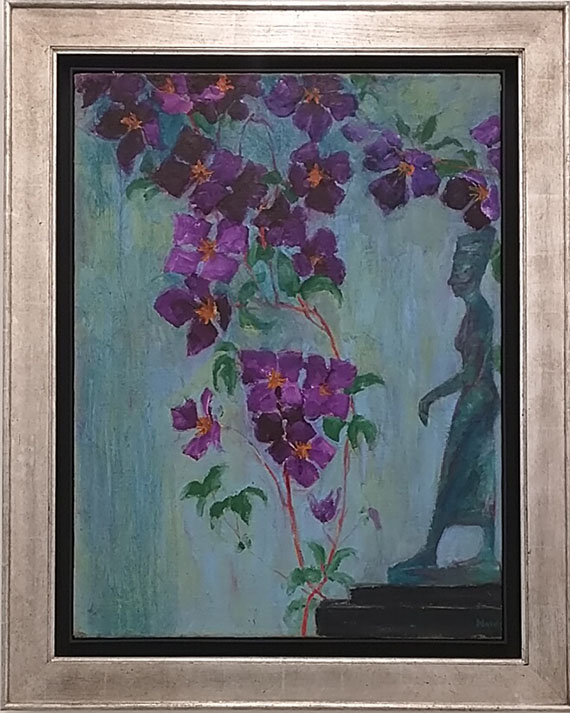226
Emil Nolde
Figur und Clematis, 1935.
Oil on canvas
Estimation:
€ 500,000 / $ 590,000 Résultat:
€ 721,000 / $ 850,780 ( frais d'adjudication compris)
Figur und Clematis. 1935.
Oil on canvas.
Urban 1145. Lower right signed. Signed and titled on the stretcher. 88.5 x 67.5 cm (34.8 x 26.5 in).
The depicted figure is an Egyptian bronze from Emil Nolde's possession.
This is the only still life with exotc figures by Emil Nolde from these days.
PROVENANCE: From the artist's estate.
EXHIBITION: Emil Nolde, Das Kunsthaus Rudolf Probst, Mannheim 1937.
Emil Nolde. Kunstverein, Cologne, 13 May - 2nd July 1950/ Märkisches Museum Witten July 1950, no. 10.
Kunsthalle Kiel, August 1950.
Emil Nolde, Kunsthalle, Kiel, 22 June - 27 July 1952, no. 26.
Emil Nolde. Zum 86. Geburtstag, Kunstverein Düsseldorf, 19 July - 30 August 1953.
Copenhagen, Charlottenborg Castle, 18 April - 4 May 1958, no. 71
Emil Nolde - Die stille Welt der Dinge. Blumen, Masken und Figuren. Nolde Foundation Seebüll, Berlin branch 26 April - 20 October 2013.
Oil on canvas.
Urban 1145. Lower right signed. Signed and titled on the stretcher. 88.5 x 67.5 cm (34.8 x 26.5 in).
The depicted figure is an Egyptian bronze from Emil Nolde's possession.
This is the only still life with exotc figures by Emil Nolde from these days.
PROVENANCE: From the artist's estate.
EXHIBITION: Emil Nolde, Das Kunsthaus Rudolf Probst, Mannheim 1937.
Emil Nolde. Kunstverein, Cologne, 13 May - 2nd July 1950/ Märkisches Museum Witten July 1950, no. 10.
Kunsthalle Kiel, August 1950.
Emil Nolde, Kunsthalle, Kiel, 22 June - 27 July 1952, no. 26.
Emil Nolde. Zum 86. Geburtstag, Kunstverein Düsseldorf, 19 July - 30 August 1953.
Copenhagen, Charlottenborg Castle, 18 April - 4 May 1958, no. 71
Emil Nolde - Die stille Welt der Dinge. Blumen, Masken und Figuren. Nolde Foundation Seebüll, Berlin branch 26 April - 20 October 2013.
The exhibition at the Mannheim art shop Rudolf Probst, where the painting, along with 90 other works, was on display in 1937, lasted only three days. The president of the "Reichskunstkammer" had it shut down. The exhibition "Degenerate Art" comprised 29 paintings, as well as watercolors and graphic works by Emil Nolde. In the light of these circumstances the consequences were foreseeable and Nolde's choice of subject was limited. Flower pictures and landscapes did not seem to be affected thereby. However, the verdict was imposed on the artist and his works and the occupation ban that came into effect in 1941 marked the peak of this development. But Nolde's creative power remained strong. Emil Nolde had already developed an interest in the landscape of his surroundings and the flowers in his garden, both supplied him with some of his most wonderful motifs. The combination of flowers with small bronzes and porcelain objects from a domestic setting began at a much earlier point. Initially Nolde made studies for his still lifes with exotic figures at the Berlin museum of ethnology, but he soon began to compile his own collection with great passion. Wherever he went he visited markets and antique shops in search of new treasures. He acquired whatever he liked, while putting a focus on form and color. The balance between the blossoms and the Egyptian bronze was of crucial importance to Emil Nolde. That may have been the reason why he decided to truncate the painting's right margin in order to underline the Clematis' role as the main actor of the charming composition. Nolde's preference for strong colors becomes quite obvious. In the days the painting was made Nolde attributed synaesthetic characteristics to the colors and employed them as conveyors of symbolic meaning. The Cleamtis' almost unreal blue-purple is intensified through the neutral background in pale shades of blue and green. The background in various shades of turquoise seems cool and exhilarant. Turquoise is considered the color of a clear creative expression, of creative power and communication. Just as it is the case with white, it symbolizes truth. A clematis grows out of this background of symbolical creativity and comes to full bloom in the center of the picture. Just like the colors, certain characteristics were also ascribed to plants. The clematis is often used in alternative medicine. It stands for imagination and creativity. The color purple fittingly stands for magic, inspiration and spirituality. This way Nolde's choice of color underlines the flower's qualities. The mysterious female figure, which calls strong reminiscence of the Egyptian queen Nefertiti, enters the mystical composition on the right. The flower pictures, which make for a large part of Emil Nolde's oeuvre, should be particularly esteemed for their peculiarity, as they are characterized by the same increased sensation that is so typical of Emil Nolde's creation in general. At all its levels of interpretation "Figur und Clematis" is not only a touching aesthetic arrangement, but also a wonderful document of the manifold ways Nolde used to work himself into a composition. [KD]
226
Emil Nolde
Figur und Clematis, 1935.
Oil on canvas
Estimation:
€ 500,000 / $ 590,000 Résultat:
€ 721,000 / $ 850,780 ( frais d'adjudication compris)




 Lot 226
Lot 226 
